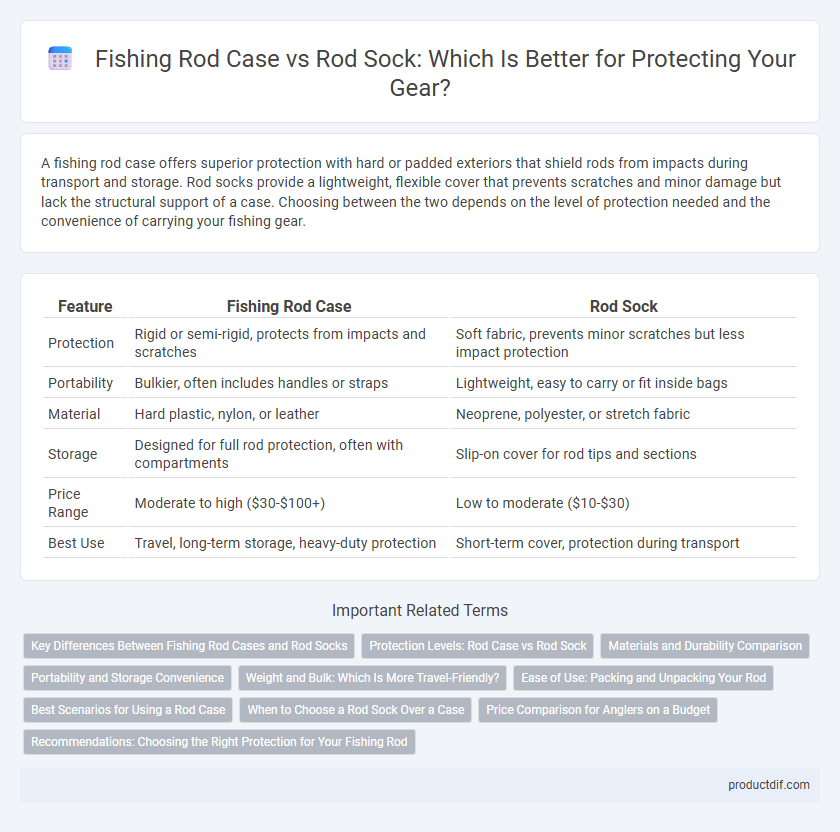A fishing rod case offers superior protection with hard or padded exteriors that shield rods from impacts during transport and storage. Rod socks provide a lightweight, flexible cover that prevents scratches and minor damage but lack the structural support of a case. Choosing between the two depends on the level of protection needed and the convenience of carrying your fishing gear.
Table of Comparison
| Feature | Fishing Rod Case | Rod Sock |
|---|---|---|
| Protection | Rigid or semi-rigid, protects from impacts and scratches | Soft fabric, prevents minor scratches but less impact protection |
| Portability | Bulkier, often includes handles or straps | Lightweight, easy to carry or fit inside bags |
| Material | Hard plastic, nylon, or leather | Neoprene, polyester, or stretch fabric |
| Storage | Designed for full rod protection, often with compartments | Slip-on cover for rod tips and sections |
| Price Range | Moderate to high ($30-$100+) | Low to moderate ($10-$30) |
| Best Use | Travel, long-term storage, heavy-duty protection | Short-term cover, protection during transport |
Key Differences Between Fishing Rod Cases and Rod Socks
Fishing rod cases provide rigid or semi-rigid protection, often featuring hard shells or reinforced materials to safeguard rods from impact during transport, while rod socks offer lightweight, flexible fabric sleeves designed primarily to prevent scratches and tangles. Cases typically include compartments and padding for organized storage and enhanced durability, whereas rod socks focus on easy slip-on application and breathability for rod maintenance. Choosing between a fishing rod case and a rod sock depends on the level of protection required, portability preferences, and storage convenience.
Protection Levels: Rod Case vs Rod Sock
Fishing rod cases offer superior protection levels compared to rod socks by providing a rigid or semi-rigid shell that shields rods from impacts, crushing, and environmental hazards. Rod socks, typically made of soft neoprene or fabric, primarily prevent scratches and minor abrasions but lack structural defense against heavy pressure or drops. For anglers prioritizing maximum rod protection during travel or rough conditions, investing in a well-padded or hard-shell rod case is essential.
Materials and Durability Comparison
Fishing rod cases often feature hard or semi-rigid materials like EVA foam or molded plastic, providing superior protection against impact, scratches, and moisture, which enhances durability during transport and storage. In contrast, rod socks are typically made from stretchable, lightweight fabric such as neoprene or polyester, offering basic abrasion resistance but limited structural protection. The choice between the two depends on the need for maximum durability and impact resistance versus lightweight, flexible covering for everyday use.
Portability and Storage Convenience
Fishing rod cases provide superior protection with rigid or semi-rigid structures, making them ideal for long trips and rough handling, while maintaining moderate portability. Rod socks offer lightweight, flexible coverage, enhancing portability and easy storage by conforming to the rod shape but sacrificing some protection. Choosing between the two depends on prioritizing storage convenience and protection versus lightweight, space-saving transport for fishing gear.
Weight and Bulk: Which Is More Travel-Friendly?
Fishing rod cases generally offer more protection but are heavier and bulkier, making them less travel-friendly compared to rod socks. Rod socks are lightweight and slim, allowing for easy packing in luggage or backpacks without adding significant bulk. For anglers prioritizing portability and minimal weight, rod socks provide a more convenient solution during travel.
Ease of Use: Packing and Unpacking Your Rod
Fishing rod cases provide structured protection with hard or semi-rigid exteriors, allowing easier and more secure packing and unpacking compared to rod socks, which are made of flexible fabric that offers minimal padding but quick access. Rod sock users benefit from lightweight, compact storage that slips on and off easily, ideal for transport without hassle but less safeguard against impact. For anglers prioritizing quick packing and protection, fishing rod cases optimize ease of use, while rod socks suit those needing fast, convenient rod coverage.
Best Scenarios for Using a Rod Case
A fishing rod case provides superior protection in scenarios involving travel or long-term storage by preventing damage from impacts and environmental elements. It is ideal for anglers transporting multiple rods or using frequent air or vehicle travel where durability and secure containment are paramount. Compared to rod socks, which offer minimal protection primarily against scratches, rod cases ensure the integrity of expensive graphite or fiberglass rods during rigorous handling and harsh conditions.
When to Choose a Rod Sock Over a Case
Choose a rod sock over a fishing rod case when you need lightweight, flexible protection that easily fits into crowded tackle bags or backpacks. Rod socks are ideal for short trips or casual fishing where minimal protection against scratches and tangling is sufficient. They are less bulky and more affordable compared to structured rod cases, making them perfect for anglers prioritizing convenience and portability.
Price Comparison for Anglers on a Budget
Fishing rod cases generally offer more protection but come at a higher price, often ranging from $30 to $100 depending on materials and brand. Rod socks provide a budget-friendly alternative, typically costing between $10 and $25, suitable for anglers looking for lightweight, basic protection. For budget-conscious anglers, rod socks deliver affordable storage, while rod cases justify their cost with durability and enhanced rod safety.
Recommendations: Choosing the Right Protection for Your Fishing Rod
When selecting protection for your fishing rod, consider a fishing rod case for superior durability, impact resistance, and organized storage, especially for frequent travel or rough conditions. Rod socks offer lightweight, flexible protection ideal for preventing scratches and minor abrasions during casual transport or short trips. Opting for a case or sock should align with your fishing habits, transport methods, and the level of protection needed to preserve your rod's performance and longevity.
Fishing Rod Case vs Rod Sock Infographic

 productdif.com
productdif.com